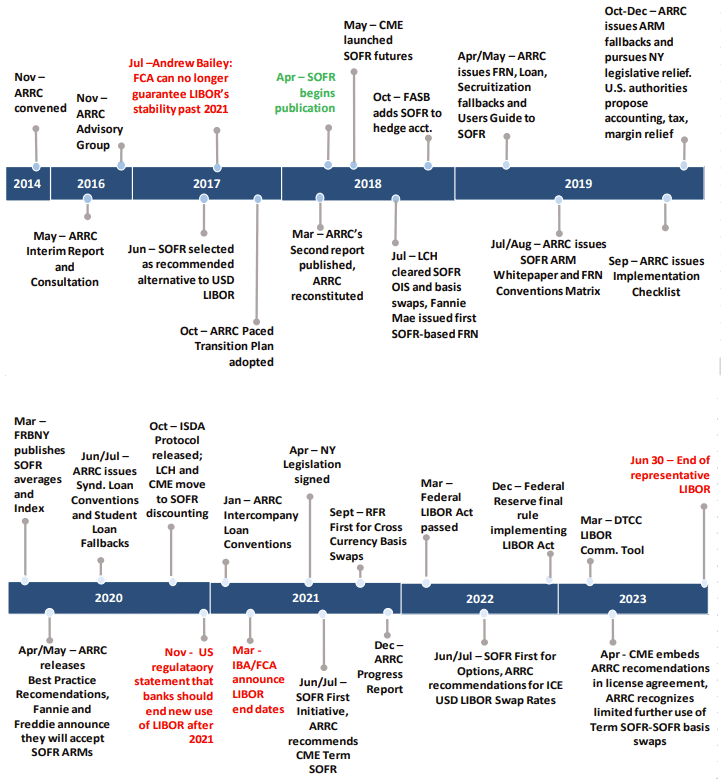Financial Markets
Thursday, March 28, 2024
By John Hintze
In a report last November, the Alternative Reference Rates Committee declared success as it closed the book on supplanting the Libor benchmark in the U.S. with the Secured Overnight Financing Rate (SOFR). But it did not say that all work is complete.
ARRC’s website remained open though deactivated, as the committee said that its closing report highlighted “key areas that the ARRC believes firms should focus on going forward to preserve the robust system of reference rates achieved through the decade-long transition effort.”
“We must uphold the lessons from the transition to avoid ever needing to repeat it again,” said Federal Reserve Bank of New York president and CEO John C. Williams.
“I urge all market participants to take the closing report’s messages to heart to ensure robust reference rates endure,” said ARRC Chair Peter Phelan, managing director in the Office of the Chief Operating Officer at Citi.
The ARRC described three areas of focus for firms to “preserve the much more robust system of reference rates that has been achieved”:
The ARRC recommended extending the use of term SOFR to basis swaps that enable swap dealers to reduce the exposure, but it otherwise held firm.
In September 2019, executives of 10 large regional banks argued in a letter to banking regulators that standalone SOFR would cause banks’ funding costs to increase during stress periods while the risk-free rate falls, along with their loan revenue.
“The natural consequence of these forces will either be a reduction in the willingness of lenders to provide credit in a SOFR-only environment, particularly during periods of economic stress, and/or an increase in credit pricing through the cycle,” the letter said.

USD Libor transition timeline, from the ARRC Closing Report.
A July 2023 statement by the International Organization of Securities Commissions (IOSCO) questioned the fitness of certain credit-sensitive rates – clearly referring to Ameribor and BSBY – because they are generated from bank-issued commercial paper (CP) and certificates of deposit (CD). Those markets “are not sufficiently deep, robust and reliable to underpin alternatives to USD Libor,” IOSCO said. “Further, gaps in data and volatility related to reliance on a very small number of transactions mean that USD Libor alternatives based on these markets are unlikely to sufficiently implement” IOSCO’s benchmark design principles.
On November 15, Bloomberg announced it would discontinue BSBY in November 2024.
AFX is pushing ahead with Ameribor. After the IOSCO statement, AFX chief executive John Shay told GARP that CP and CD were a “great source” of data to develop a term structure. He stressed that the daily Ameribor, derived from unsecured funding transactions matched over AFX, reflects actual bank funding costs.
"We have discovered hundreds of banks are using our benchmark to write conforming home mortgage loans, warehouse lines of credit, car loans, credit lines, etc.,” Shay said in a more recent interview. “We are thrilled the market has found value in our [credit-sensitive rate] offering."
Ian Walker, head of legal innovation at Covenant Review, said he has not observed banks using Ameribor or BSBY for large institutional loans.
Lenders in the institutional market typically are collateralized loan obligations (CLOs), insurance companies, family offices, hedge funds and others using third-party capital rather than their balance sheets for funding, Walker explained. Banks, on the other hand, have credit-risk exposure through revolving credit facilities, which tend to be drawn only when the borrower faces a liquidity issue, at which time the cost of funding would equal SOFR.
Veteran analyst Ethan Heisler, editor of Bank Treasury Newsletter, noted that SOFR faced a test in March 2023, when Silicon Valley Bank and Signature Bank failed. However, floating-rate SOFR adjusted as bank funding costs rose, and “there was literally no problem for banks to make loans in the wake of SVB,” Heisler said.
The Federal Reserve also played a key role, he added, by maintaining its standing repo facility, introduced in July 2021, and ample reserves in the system to ensure adequate bank funding.
The regional banks’ letter recommended creating a credit-risk premium to layer on top of SOFR that would reflect banks’ cost of funds. Such a premium was described by Stanford University’s Darrell Duffie and two co-authors in a July 2020 paper. In July 2022, Invesco Indexing and SOFR Academy launched the USD Across-the-Curve Credit Spread Indices (AXI) and USD Financial Conditions Credit Spread Indices (FXI), which “do not suffer from the same flaws that led to the demise of Libor,” said SOFR Academy CEO Marcus Burnett.
He said rather than building a synthetic Libor, the academics sought to maximize the robustness and representativeness of the benchmark’s credit spreads and ensure flexibility in the composition of bank funding. AXI and FXI (which follows AXI’s methodology but with a broader range of financial transactions) use all available transactions across the yield curve out five years, inhibiting manipulation.
In the U.K., a 3-month sterling Libor setting, based on an “unrepresentative synthetic methodology,” will not be published after March 28, according to ICE Benchmark Administration. IBA is also required by the Financial Conduct Authority to continue to publish 1-, 3- and 6-month synthetic USD Libor settings until September 30 “when the FCA expects publication to cease,” IBA said on February 29.
Burnett said the AXI and FXI benchmarks are especially appropriate for large regional banks providing revolving credits that corporate clients can draw down. Invesco, with more than $1.5 trillion in assets under management, indicated there is interest among lenders.
Dr. Ping Sun of Numerix
The indexes “are available for license, and we can confirm that AXI has been licensed for use,” according to an Invesco spokesperson.
Whether the credit-sensitive component becomes a mainstay remains to be seen, but loan market participants relying solely on SOFR may one day rue not having a credit-risk cushion. Ping Sun, senior vice president of financial engineering at analytics provider Numerix, said that clients have asked about how to construct a value at risk (VaR) time series for SOFR, given the complexity in calculating the rate’s historical options volatility.
“We’ve heard from clients that they might use Libor volatility as a proxy, but the question is how, given their different underlying transactions,” Sun said.
Ola Hammarlid, chief control officer at Swedbank in Sweden until last December, noted that proxies always introduce error into risk modeling, since their different risk factors may deviate, reducing the accuracy of a backward-looking proxy.
“The proxy may work for a while, but who knows what the next stressful event will look like?” Hammarlid said. A derivative generated from a proxy could unexpectedly deviate from the underlying asset or liability it is hedging, “so you end up not being fully protected, even when you think you are.”
•Bylaws •Code of Conduct •Privacy Notice •Terms of Use © 2024 Global Association of Risk Professionals



